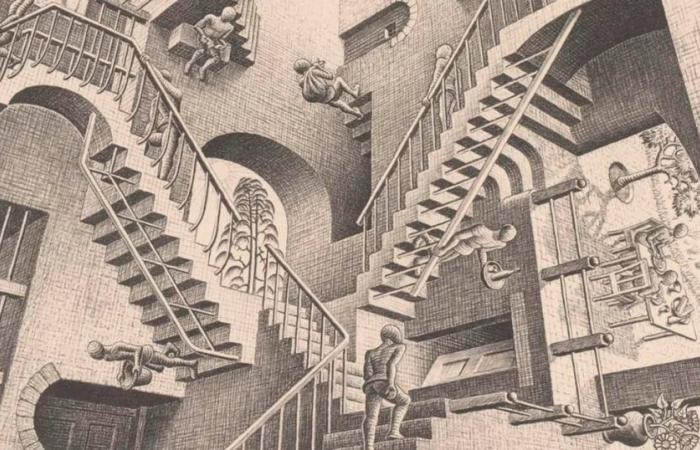In 1941, MC Escher He moves to Baarn, in the Netherlands. He has been escaping from fascism, which is advancing through Europe and which had already forced him, with the assent of Mussolinito leave his beloved Italy.
Winter falls in Baarn, a long white night, the cold and the snow-saturated roads prevent you from enjoying the colors of nature, the planted fields, the flowering trees. A closed-in man, an unknown artist who until then had dedicated himself to landscaping – with his own style, of course – must face his demons, the images in his head emerge, the works flow, he makes a drastic change in his career there, which They made him one of the most recognized creators in the world: labyrinthine constructions in a space that distorts.
Before he had lived in Switzerland and Belgium, where he never felt comfortable, and on some trips to the south of Spain he received one of his great influences, but not from its painters as one might think, but from the Alhambra mosque, where he learned about art. Mudejar that ornaments, with geometric patterns, the walls, columns and ceilings.
The process towards Relativityperhaps his best-known work, was slow, since he made this piece in 1953, taking inspiration from the theory of Albert Einsteinpublished in 1905, with which he had become obsessed and which ended up defining his own idea of the world: there is much more to see than what the eyes allow us.
During his first years, Maurits Cornelis Escherwho today marks the 126th anniversary of his birth in Leeuwarden (Netherlands), spent a long time in bed due to various illnesses, attending a primary school in Zandvoort, where he suffered mental and physical violence from his classmates who ridiculed him. for the sailor suit that his mother forced him to wear as a uniform for classes, while at home he received musical training, piano and violin, and also carpentry lessons, since his father wanted him to be an architect.
Between 1912 and 1918, he was a mediocre student at the Hogere Burger school, whose building is built around an intricate central staircase, and which would inspire many years later Relativity, among other pieces. He was not happy there either and from a 1919 letter to his girlfriend he recalled those years as “the hell that was Arnhem” and from another to a friend, in 1924, more clues emerge: “The HBS desks in Arnhem, a memory damned. I shudder to think about it.” The reality is that MC Escher was, throughout his life, a man of few words, who did not dwell on his private life, with the use of synthetic irony and some even portray him as a chronic bad mood.
Escher is one of the most reproduced artists in history, her ability to create optical illusions not only live on t-shirts or mugs, but can be found in all types of books, from psychology to school books. Everyone at some point saw an Escher even if they didn’t know it.
However, despite this ‘popularity’, its entry into the pantheon of Art History occurred already in this century. His work was looked at with disdain, cataloged as part of the corpus of graphic design, of industrial design, and he had to wait until he was 70 years old to hold his first retrospective exhibition, in his native country.
His first great recognition came in this part of the planet: an exhibition in Brazil in 2011 brought together more than half a million people, which led, in 2015, to have his first exhibition in the United Kingdom, at the National Gallery of Art Modern of Scotland, who would later act in London, Rome and Milan.
His legacy includes more than 400 lithographs and wood engravings, around 2,000 drawings and drafts, and countless reproductions. Relativity, for example, belongs to a series of five prints with impossible constructions and multiple vanishing points. She did it when her career began to grow and she was no longer dependent on her parents to survive.
And with pieces like Belvedere (1958), Ascending and Descending (1960) and waterfall (1961) he became a cult artist, and with the rise of the hippie community as the cultural standard of the time, his “psychedelic” works gained more and more followers.
In 1969, his lithograph Ascending and Descending It was used for the album cover L the P of The Scaffoldband led by the brother of Paul MCCARTNEYand Reptiles (1943) on the debut album of Mott the Hoopleboth British.
That same year, Mick jagger He wrote to him for permission to reproduce a work in front of Through the Past, Darklythird compilation album The Rolling Stones. It was not successful. In an overconfidence, the leader of the group headed the letter with “Maurits” and he asked his assistant: “Please tell Mr. Jagger that I am not Maurits to him.”
But this was not the first time he had rejected the invitation of a global star, because in 1965, the American filmmaker Stanley Kubrick had summoned him to assist him in 2001: Space Odyssey to give the film a “fourth dimension” aspect.
Without a doubt, it was cinema where his works had the greatest influence. In recent years, under the concept of multiverse that predominated over the narrative of Marvel films, especially from those that appear Dr Strangeyou can see this confluence of architectural spaces mirroring each other, being consumed by each other, although it is in the mythical Labyrinth (1986), from Jim Hensonwhere the most literal tribute is performed in a musical scene inside the castle of the King Jarethinterpreted by David Bowie.
But he was not the first, that honor belongs to the Italian Dario Argento in Suspiria (1977), which was inspired by Concave and convex and in Bird/Fish, both from 1955, for different scenes. Other references can be seen in the infinite stairs of inception (2010) Christopher Nolanas in the saga of Harry Potter -from the book to the cinema- with its magical stairs at Hogwarts.
In television products, the work Castrovalva (1930) gave the name and setting to four episodes of season 19 of Dr Whoin 1982, and Matt Groening paid tribute to him both in The Simpsonin several seasons, as in a gag of Futuramain its first season, to name a few series with massive reach.
MC Escher He was an artist without a school, the difficulty of classifying him within a movement or avant-garde, beyond some connections with surrealism, which theorists like so much, caused him to be left aside. He created outside the trends of modern art, at a time when abstraction was the main language.
That makes his work even more authentic, more personal, because it develops apart from what was happening in the world, arising in a cabin surrounded by a long white night, and his ideas about eternity, about infinity, from a impossible realism, they were -and are- close to everyone, they do not need theories or archetypal constructions to be validated. That’s why MC Escher, even though he wasn’t interested in him, became a popular artist.






